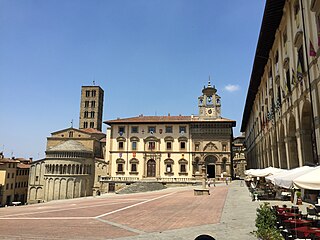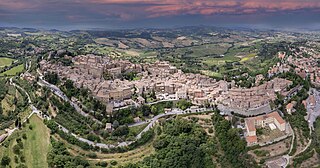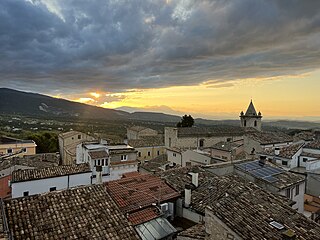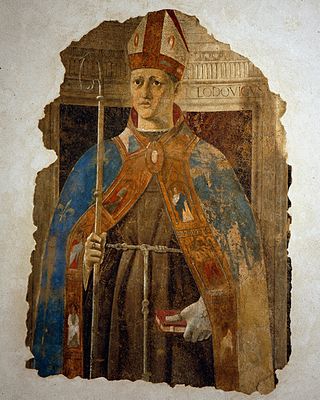
Arezzo is a city and comune in Italy and the capital of the province of the same name located in Tuscany. Arezzo is about 80 kilometres southeast of Florence at an elevation of 296 metres (971 ft) above sea level. As of 2022, the population was about 97,000.

Piero della Francesca was an Italian painter, mathematician and geometer of the Early Renaissance, nowadays chiefly appreciated for his art. His painting is characterized by its serene humanism, its use of geometric forms and perspective. His most famous work is the cycle of frescoes The History of the True Cross in the Basilica of San Francesco in the Tuscan town of Arezzo.

Montepulciano is a medieval and Renaissance hill town and comune in the Italian province of Siena in southern Tuscany. It sits high on a 605-metre (1,985 ft) limestone ridge, 13 kilometres (8 mi) east of Pienza, 70 kilometres (43 mi) southeast of Siena, 124 kilometres (77 mi) southeast of Florence, and 186 kilometres (116 mi) north of Rome by car.

Guardiagrele is a town and comune in the province of Chieti, part of the Abruzzo region of central Italy. It is in the foothills of the Maiella mountain at an elevation of around 576 metres (1,890 ft). Its population numbers about 10,000.

Sansepolcro, formerly Borgo Santo Sepolcro, is a town and comune founded in the 11th century, located in the Italian Province of Arezzo in the eastern part of the region of Tuscany.

Antonio d'Enrico, called Tanzio da Varallo, or simply il Tanzio was an Italian painter of the late-Mannerist or early Baroque period.

Giovanni Antonio Fasolo (1530–1572) was a late Renaissance Italian painter of the Venetian school, active in Vicenza and surroundings.
The decade of the 1460s in art involved some significant events.

The Resurrection is a fresco painting by the Italian Renaissance master Piero della Francesca, painted in the 1460s in the Palazzo della Residenza in the town of Sansepolcro, Tuscany, Italy.

Lorenzo di Bicci was an Italian painter of the Florentine School considered to be one of the most important painters in Florence during the second half of the 14th century. He is believed to have learned his trade from his father, about whom little is known. Lorenzo’s style, as well as that of his contemporaries Jacopo di Cione and Niccolò di Pietro Gerini, was influenced by the artist Andrea di Cione. Lorenzo's paintings made use of bright colors and his compositions avoided complexity. The figures he painted tended to have round faces and were often expressionless. Another one of Lorenzo's distinctive characteristics was his precision of execution. He was known for exceptional talent in drawing, an ability that he put to use at the initial stages of his painting. Unlike many celebrated Florentine artists of this period, Lorenzo mostly received commissions from the country clergy and from the lower-middle-class Florentine guilds. His successors, Bicci di Lorenzo and Neri di Bicci, continued to serve these groups.

Antonio del Massaro da Viterbo, or Antonio da Viterbo, nicknamed il Pastura was an Italian painter.

Scarperia is a frazione of the comune (municipality) of Scarperia e San Piero, located in the Metropolitan City of Florence, in Tuscany, Italy, about 30 kilometres (19 mi) north of Florence. It was an independent comune until 1 January 2014.

The Museo Civico di Montepulciano, also known as the Museo Civico Pinacoteca Crociani, is the town or comune art gallery and museum. It is housed in the medieval Palazzo Neri Orselli, a 14th-century structure located on Via Ricci #10, corner with Via Talosa, in the center of the town of Montepulciano, in the Province of Siena, region of Tuscany, Italy. The museum was founded in 1954.
The Pinacoteca Comunale di Deruta, located in the town's municipal office building, the medieval Palazzo dei Consoli is the town or comune art gallery and museum. It is located on Piazza dei Consoli 15 in the town center of Deruta, in the Province of Perugia, region of Umbria, Italy. The small town also houses the Museo Regionale della Ceramica.

Saint Louis of Toulouse is a fresco fragment of 1460 by Piero della Francesca, removed from its original wall in the former Palazzo Pretorio in Sansepolcro, Tuscany, in the mid-19th century, and now in the Museo Civico in the same town. The detachment destroyed a Latin inscription recording Ludovico Acciaioli as the commissioner and 1460 as the work's date, on the occasion of the town's revival of the role of gonfaloniere of justice.

The Palazzo dei Priori is a 13th-century civic palace located in Piazza del Plebiscito in central Viterbo, region of Lazio, Italy. Known in the past also as the Palazzo della Commune or Comunale, it now houses both municipal offices and the Museo dei Portici, which houses the famous altarpieces by Sebastiano del Piombo, depicting a Pietà and a Flagellation. The Palace is connected and accessible through an arch over Via Filippo Ascenzi to the former Palazzo del Governatore or Palazzo del Podesta, behind which rises a tall medieval clock tower. Its largest bell deriving from the church of Santa Maria della Verita. Across the piazza on the north end of the Palazzo dei Priori is the church of Sant'Angelo in Spatha, which has a marble replica of the Ancient Roman Sarcophagus of Bella Galiana on the facade. To the left of the palace, facing the piazza is the baroque Palazzo della Prefettura.














